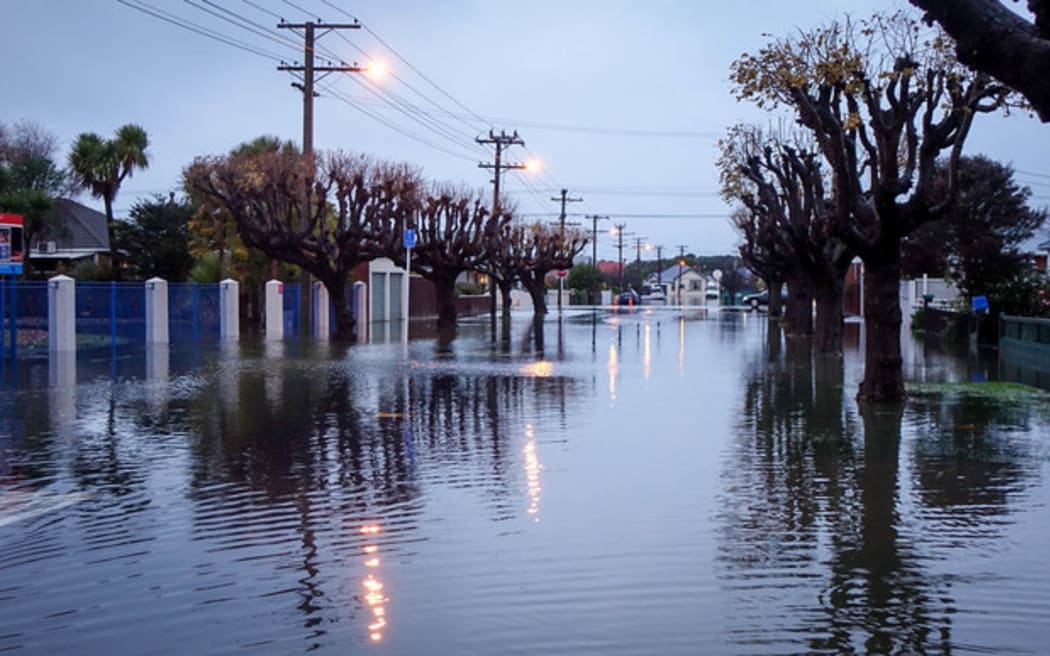Sixteen ideas have made the shortlist in South Dunedin's "plan for a plan" over regular flooding

Photo: RNZ
South Dunedin's been through the wringer - the area in Ōtepoti colloquially known as "The Flat" or “South D” has faced flood after flood - and the frequency is likely to increase as climate change takes hold.
As sea levels rise parts of South Dunedin will be below the high tide mark. Floodwaters drain slowly so the threat of increasingly heavy downpours make this part of the city and its inhabitants highly vulnerable.
In response, local councils have come up with a list of 16 new "approaches" to make South Dunedin more resilient.
The Detail speaks to two Dunedinites to find out just exactly what South Dunedin's facing, what these new approaches entail and when they might be implemented.
Tess Brunton is RNZ's Otago-Southland reporter.
"[South Dunedin's] really densely populated, it's low lying and it's home to more than 13,000 people. But it was built on a former tidal wetland, so sandwiched between the hills, the harbour and the ocean," she explains.
"There's about 6000 odd households and more than 40 percent are rented. One of the reasons why it's got a population where there is older people and people who perhaps have accessibility needs is because it is flat in a hilly city - it's easier for people to walk around."
But this tight-knit community was heavily impacted by a flood in June 2015. More than 1000 homes and businesses were damaged.
Jonathan Rowe is the Dunedin City Council's manager for South Dunedin Future - the project which has come up with these ideas to protect the area’s residents.
Although Dunedin born-and-bred, he wasn't living in Dunedin in 2015 - but he's certainly been told about it.
"When you get water coming in your house - it's terrible, it's every homeowner's worst nightmare," he says.
"We've heard lots of stories about people having to move out, losing lots of their possessions, having water that's contaminated with sewage in and around the place - it's not pleasant and certainly something we want to avoid."
So these 16 ideas have been developed, which Rowe describes as a "plan for a plan".
They've whittled it down from around 280 ideas, and it's just been approved by the Dunedin City Council and Otago Regional Council for the next phase - community consultation.
What's Rowe's pick of the bunch?
"I think the one I really like the idea of is creating more space for water, so natural spaces," he says.
"So how do you maybe take a park that's currently flat and maybe look at lowering that so if and when it rains, the floodwater goes into the park and you might not be able to use the park for a couple of days but then it drains away and you're good again. Better the flooding goes there than going in our homes and our living rooms and our basements!”
The now defunct racecourse, Forbury Park, which will soon be up for sale could play a major role as a place to hold water.
Rowe also talks to The Detail about the other ideas which include managed retreat, building higher-density housing in safer areas and lifting homes off the ground.
"It's a long list and we need to do some work to narrow it down, and that's the next stage of the programme,'' he says.
"We've got a couple of years now to figure out the plan and this thing's got a hundred-year horizon.
"One of the things we want to really guard against and get people moving away from is this idea that 'do we stay or do we go' - this black and white issue of we dig in for as long as we can and then there's a day that comes where everyone is out - that's what we want to avoid."



